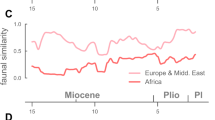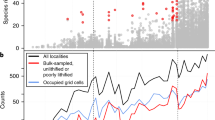A map of termite generic richness worldwide shows that the Ethiopian biogeographical region is most genus-rich, while the Neotropical and Indo-Malayan regions are less rich. Net primary productivity (NPP) has been postulated as a possible explanation for some diversity patterns (energy-diversity theory). We reject this as the primary explanation for termite generic richness patterns because the Ethiopian region has low NPP and a high generic richness while the Neotropical and Indo-Malayan regions have high NPP and low generic richness. We explore an alternative historical hypothesis, that differing levels of Quaternary climatic disturbance are responsible for the differences in termite generic richness between the three tropical regions.
Similar content being viewed by others
References
Abe T. and Masumoto T. (1979) Studies of the distribution and ecological role of termites in a lowland rainforest of west Malaysia. 3. Distribution and abundance of termites in Pason Forest Reserve. Jap. J. Ecol. 29, 337–51.
Adams J.M. and Woodward F.I. (1989) Patterns in tree species richness as a test of the glacial extinction hypothesis. Nature 339, 699–701.
Ahmad M. (1950) The phylogeny of termite genera based on imago-worker mandibles. Bull. Am. Mus. Nat. Hist. 95, 37–86.
Axelrod D.I. and Raven P.H. (1978) Late Cretaceous and tertiary vegetation history of Africa. In Biogeography and Ecology of Southern Africa (M.G.A. Werger, ed.) pp. 77–130. The Hague: W. Junk.
Brown J.H. (1981) Two decades of homage to Santa Rosalia: towards a general theory of diversity. Am. Zool. 21, 877–88.
Brown J.H. and Davidson D.W. (1977) Competition between seed eating rodents and ants in desert ecosystems. Science 196, 880–2.
Collins N.M. (1977) Oxford expedition to the Edea-Marienberg Forest Reserve, United Republic of Cameroon. Bull. Oxf. Univ. Explor. Club, New Series 3, 5–15.
Collins N.M. (1984) The termites (Isoptera) of the Gunung Mulu National Park, with a key to the genera known from Sarawak. Sarawak Mus. J. 30, 65–87.
Collins N.M. (1989) Termites. In Ecosystems of the World: Tropical Rain Forest Ecosystems (H. Lieth and M.J.A. Werger, eds) pp. 455–72. Holland: Elsevier.
Colyn M., Gautier-Hion A. and Verheyen W. (1991) A re-appraisal of palaeoenvironmental history in central Africa: evidence for a major fluvial refuge in the Zaire basin. J. Biogeog. 18, 403–7.
Constantino R. (1992) Abundance and diversity of termites (Insecta: Isoptera) in two sites of primary rain forest in Brazilian Amazonia. Biotropica 24, 420–30.
Crook K.A.W. (1981) The break up of the Australasian-Antarctic segment of Gondwanaland. In Ecological Biogeography of Australia (A. Keast, ed.) pp. 3–14. Holland: W. Junk.
Currie D.J. (1991) Energy and large scale patterns of animal and plant species richness. Am. Nat. 137, 27–49.
Currie D.J. and Paquin V. (1987) Large scale biogeographic patterns of species richness of trees. Nature 329, 326–7.
Delany M.J. and Happold D.C.D. (1979) Ecology of African Mammals. London: Longman.
Dieterlen F. (1989) Rodents. In Ecosystems of the World: Tropical Rain Forest Ecosystems (H. Lieth and M.J.A. Werger, eds) pp. 383–400. Holland: Elsevier.
Eggleton, P., Bignell, D.E., Sands, W.A., Waite, B., Wood, T.G. and Lawton, J.H. (in press) The species richness of termites under differing levels of forest disturbance in the Mbalmayo Forest Reserve, southern Cameroon. J. Trop. Ecol.
Endrödi S. (1985) The Dynastinae of the World. The Hague: W. Junk.
Gaston K.J. and Williams P.H. (1993) Mapping the world's species-the higher taxon approach. Biodiver. Lett. 1, 2–8.
Groombridge (1992) Global Biodiversity London: Chapman & Hall.
Grassé P.P. (1985) Termitologia, Volume 3. Paris: Masson.
Gray F.J. and Calaby J.H. (1970) Termites of the Australasian region. In Biology of Termites, Volume 2 (K. Krishna and F.M. Weesner, eds) pp. 393–448. New York: Academic Press.
Hamilton A. (1989) African Forests. In Ecosystems of the World: Tropical Rain Forest Ecosystems (H. Lieth and M.J.A. Werger, eds) pp. 155–82. Holland: Elsevier.
Huttel C. (1975) Recherches sur l'ecosystème de la fôret subéquatorial de basse Côte d'Ivoire, III. Inventaire et structure de la végétation ligneuse. Terre Vie, Rev. Ecol. Appl. 29, 178–91.
Johnson R.A., Lamb R.W., Sands W.A., Shittu R.M., Williams R.M.C. and Wood T.G. (1980) A check list of Nigerian termites (Isoptera) with brief notes on their biology and distribution. Nigerian Field 12, 50–65.
Karr J.R. (1976) Within- and between-habitat avian diversity in African and Neotropical lowland habitats. Ecol. Monogr. 46, 457–81.
Karr J.R. (1989) Birds. In Ecosystems of the World: Tropical Rain Forest Ecosystems (H. Lieth and M.J.A. Werger, eds) pp. 401–16. Holland: Elsevier.
Kemp E.M. (1981) Tertiary palaeogeography and the evolution of Australian climate. In Ecological Biogeography of Australia (A. Keast, ed.) pp. 33–49. Holland: W. Junk.
Krishna K. (1970) Taxonomy, phylogeny and distribution of termites. In Biology of Termites, Volume 2 (K. Krishna and F.M. Weesner, eds) p. 127–53. New York: Academic Press.
Latham R.E. and Ricklefs R.E. (1993) Global patterns of tree species richness in moist forests: energy-diversity theory does not account for variation in species richness. Oikos 67, 325–33.
Lee K.E. and Wood T.G. (1971) Termites and Soils. New York: Academic Press.
LePage M.G. (1972) Recherches écologiques sur une savanne sahèlienne du Ferlo Septentrional, Senegal. Données preliminaires sur l'écologie des termites. Terra Vie, Rev. Ecol. Appl. 26. 383–409.
Mathews A.G.A. (1977) Studies on Termites from the Mato Gosso State, Brazil. Rio de Janeiro: Academia Brasileira de Ciências.
Owen J.G. (1988) On productivity as a predictor of rodent and carnivore diversity. Ecol. 69, 1161–5.
Pearson D.L. (1977) A pantropical comparison of bird community structure on six lowland forest sites. Condor 79, 232–44.
Sands W.A. (1965a) A revision of the termite superfamily Nasutitermitinae (Isoptera, Termitidae) from the Ethiopian region. Bull. Br. Mus. Nat. Hist. (Ent.) Suppl. 4, 1–172.
Sands W.A. (1965b) Termite distribution in man-modified habitats in West Africa, with special reference to species segregation in the genus Trinervitermes (Isoptera, Termitidae, Nasutitermitinae). J. Anim. Ecol. 34, 557–71.
Sands W.A. (1972) The soldierless termites of Africa. Bull. Br. Mus. Nat. Hist. (Ent.) Suppl. 18, 1–244.
Snyder T.E. (1947) Catalog of the termites (Isoptera) of the World. Smithsonian Miscell. Coll. 112, 1–490.
Stehli F.G. (1968) Taxonomic diversity gradients in pole location: the recent model. In Evolution and Environment (E.T. Drake, ed.) pp. 163–227. New Haven: Yale University Press.
Thapa R.S. (1981) Termites of Sabah. Sabah Forest Record 12, 1–374.
Thorne B.L. and Carpenter J.M. (1992) Phylogeny of the Dictyoptera. Syst. Ent. 17, 253–68.
Tilman D. (1982) Resource Compention and Community Structure. Princeton: Princeton University Press.
Tilman, D. (1986) Resources, competition and the dynamics of plant communities. In Plant Ecology (M. Crawley, ed.) pp. 51–75.
Tryon R. (1989) Pteridophytes. In Ecosystems of the World: Tropical Rain Forest Ecosystems (H. Lieth and M.J.A. Werger, eds) pp. 327–38. Holland: Elsevier.
Uchijima, T. and Seino, R. (1987) Distribution maps of net primary productivity of natural vegetation and related climatic elements on continents. National Institute of Agroenvironmental Sciences, Kgushu National Agricultural Experiment Station.
Webb L.J. and Tracy J.G. (1981) Australian rainforests: patterns and change. Ecological Biogeography of Australia (A. Keast, ed.) pp. 607–94. Holland: W. Junk.
Whitmore T.C. (1981) Wallace's Line and Plate Tectonics. Oxford: Clarendon Press.
Williams, P.H. (1992) WORLDMAP: priority areas for biodiversity. User manual for program version 3.
Williams. P.H. and Gaston, K.J. (In press) Measuring more of biodiversity: can higher taxon richness predict wholesale species richness? Biol. Conserv.
Wilson D.E. (1989) Bats. In Ecosystems of the World: Tropical Rain Forest Ecosystems (H. Lieth and M.J.A. Werger, eds) pp. 365–82. Holland: Elsevier.
Wood T.G., Johnson R.A., Bacchus S., Shittu M.O., and Anderson J.M. (1982) Abundance and distribution of termites (Isoptera) in a Riparian forest in the Southern Guinea savanna vegetation zone of Nigeria. Biotropica 14, 25–39.
Author information
Authors and Affiliations
Rights and permissions
About this article
Cite this article
Eggleton, P., Williams, P.H. & Gaston, K.J. Explaining global termite diversity: productivity or history?. Biodivers Conserv 3, 318–330 (1994). https://doi.org/10.1007/BF00056505
Received:
Revised:
Accepted:
Issue Date:
DOI: https://doi.org/10.1007/BF00056505




